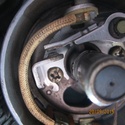The Car (Daihatsu Skywing, Like a G10/G11 Charade) has rather suddenly stopped idling.
It'll start, and run if I keep the revs above about 1500, but it stalls out if I take my foot off the accelerator. Hasn't recently run out of petrol or experienced any other problems that seem especially likely to have introduced dirt to the carburretor.
I havn't adjusted the points since I got it, so I thought I'd better start there. On the Skywing it seems more difficult than I remember.
Firstly, the distributor faces to the rear, so you can't really see what you're doing.

I tried using a mirror but then all your actions are reversed. This would take a long time to get used to, and you might not be able to walk once you had.
Short of lowering myself head-first into the engine compartment, Mission Impossible stylee,
 [/url]
[/url]
my best bet might be to rig up a webcam and laptop so I can see what I'm doing. I tried this but still couldn't see very well. I'll try it again with a light tomorrow.

The Charade G10 engine manual (distributor seems identical and the points look like a Nippon-Denso design) pretty much ignores the points gap. It specifies the heel gap, and gives the same figure for the points gap as "reference information" . I'm surprised these figures are identical, since it doesn't seem to necessarily follow, but maybe they designed it that way deliberately.
Points gap and heel gap are clearly related, but I'm not sure if its enough just to set the heel gap and assume the points gap will be correct. For one thing, I've lightly filed the points which might alter the relationship a little.
They perhaps ignore the points gap because they tell you to check the dwell angle. I don't have a dwell meter here and would probably have trouble finding anyone who knew what one was, though I suppose I could get one sent from abroad or possibly find a high-end non-automotive meter that did duty cycle. I had a Gunson meter in the UK that did tach and dwell (and some other stuff) but its probably in landfill by now.
I suppose an ordinary analogue meter reading resistance would tend to average a rapidly oscillating signal like the primary ignition circuit, due to its mechanical inertia, so its indication would be proportional to dwell, but I dunno if it'd be linear or accurate enough to be useful.
Would it be worth measuring the dwell angle "statically" (i.e. with the engine cranked manually) , fitting a pointer to the distributor-arm and directly measuring the angle it moves through while the points are open/test light is off?
It'll start, and run if I keep the revs above about 1500, but it stalls out if I take my foot off the accelerator. Hasn't recently run out of petrol or experienced any other problems that seem especially likely to have introduced dirt to the carburretor.
I havn't adjusted the points since I got it, so I thought I'd better start there. On the Skywing it seems more difficult than I remember.
Firstly, the distributor faces to the rear, so you can't really see what you're doing.

I tried using a mirror but then all your actions are reversed. This would take a long time to get used to, and you might not be able to walk once you had.
Short of lowering myself head-first into the engine compartment, Mission Impossible stylee,

my best bet might be to rig up a webcam and laptop so I can see what I'm doing. I tried this but still couldn't see very well. I'll try it again with a light tomorrow.

The Charade G10 engine manual (distributor seems identical and the points look like a Nippon-Denso design) pretty much ignores the points gap. It specifies the heel gap, and gives the same figure for the points gap as "reference information" . I'm surprised these figures are identical, since it doesn't seem to necessarily follow, but maybe they designed it that way deliberately.
Points gap and heel gap are clearly related, but I'm not sure if its enough just to set the heel gap and assume the points gap will be correct. For one thing, I've lightly filed the points which might alter the relationship a little.
They perhaps ignore the points gap because they tell you to check the dwell angle. I don't have a dwell meter here and would probably have trouble finding anyone who knew what one was, though I suppose I could get one sent from abroad or possibly find a high-end non-automotive meter that did duty cycle. I had a Gunson meter in the UK that did tach and dwell (and some other stuff) but its probably in landfill by now.
I suppose an ordinary analogue meter reading resistance would tend to average a rapidly oscillating signal like the primary ignition circuit, due to its mechanical inertia, so its indication would be proportional to dwell, but I dunno if it'd be linear or accurate enough to be useful.
Would it be worth measuring the dwell angle "statically" (i.e. with the engine cranked manually) , fitting a pointer to the distributor-arm and directly measuring the angle it moves through while the points are open/test light is off?
Last edited:

